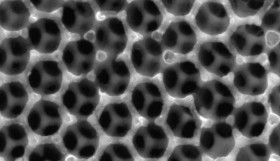I thought you said germanium was dead
December 17, 2015
on
on

It’s a bit like the mysterious tin whiskers growing in some Ge transistors I reported on a few years ago in the Mystery of the OC171 article.
As a semiconductor material, germanium is superior to silicon, explained Dr. Jay A. Switzer, the Donald L. Castleman/Foundation for Chemical Research Professor of Discovery at Missouri S&T. Germanium was used in the first transistors. It is more expensive to process for widespread use in batteries, solar cells, transistors and other applications.
Switzer and his team have had success growing other materials at the nanometer scale through electrodeposition a process that Switzer likens to growing rock candy crystals on a string. In a 2009 Switzer and his team reported that they had grown zinc oxide 'nanospears' each hundreds of times smaller than the width of a human hair on a single-crystal silicon wafer placed in a beaker filled with an alkaline solution saturated with zinc ions.
But growing germanium at the nano level is not so simple. In fact, electrodeposition in an aqueous solution such as that used to grow the zinc oxide nanospears is thermodynamically not feasible.
The M S&T team applied the ec-LLS process by electrochemically reducing indium-tin oxide (ITO) to produce indium nanoparticles in a solution containing germanium dioxide, or Ge(IV). The indium nanoparticle in contact with the ITO acts as the electrode for the reduction of Ge(IV) and also dissolves the reduced Ge into the particle, reports the Missouri S&T team. The germanium then starts to crystallize out of the nanoparticle allowing the growth of the nanowire.
I’ll see if I can recover some of that clever Germanium stuff from the transistors resting in ‘Ge Graveyard’ in my attic.
As a semiconductor material, germanium is superior to silicon, explained Dr. Jay A. Switzer, the Donald L. Castleman/Foundation for Chemical Research Professor of Discovery at Missouri S&T. Germanium was used in the first transistors. It is more expensive to process for widespread use in batteries, solar cells, transistors and other applications.
Switzer and his team have had success growing other materials at the nanometer scale through electrodeposition a process that Switzer likens to growing rock candy crystals on a string. In a 2009 Switzer and his team reported that they had grown zinc oxide 'nanospears' each hundreds of times smaller than the width of a human hair on a single-crystal silicon wafer placed in a beaker filled with an alkaline solution saturated with zinc ions.
But growing germanium at the nano level is not so simple. In fact, electrodeposition in an aqueous solution such as that used to grow the zinc oxide nanospears is thermodynamically not feasible.
The M S&T team applied the ec-LLS process by electrochemically reducing indium-tin oxide (ITO) to produce indium nanoparticles in a solution containing germanium dioxide, or Ge(IV). The indium nanoparticle in contact with the ITO acts as the electrode for the reduction of Ge(IV) and also dissolves the reduced Ge into the particle, reports the Missouri S&T team. The germanium then starts to crystallize out of the nanoparticle allowing the growth of the nanowire.
I’ll see if I can recover some of that clever Germanium stuff from the transistors resting in ‘Ge Graveyard’ in my attic.
Read full article
Hide full article


Discussion (0 comments)